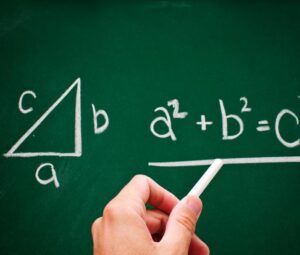Mathematics “according to Peterson” is widely known not only in Russia. In December 2018, Ludmila Georgievna’s textbook for elementary and basic schools successfully passed all the necessary examinations and returned to the federal list by numerous requests from teachers and parents. At the beginning of the school year, we asked her to tell us how to help a child with math, how to get adults interested in it, and why it is important for children to feel math magician addition.
How do you get a child interested in math if the teaching at school is mediocre?
First of all, let’s say that “mediocre teaching” is a very arbitrary term. All parents and teachers have different ideas of what it should be. But in general I understand what you mean: let’s say a child comes home from school with glazed eyes, and the word “math” makes him or her cringe.
Let’s try to understand why it is impossible to tear children away from computers, for example, as opposed to learning math. What is it that draws them to computer games? I think there are a number of factors:
they’re not forced to play;
They aren’t scolded if they don’t succeed;
Children understand the goal (to score a goal, overcome an obstacle), it’s meaningful to them, and they achieve it themselves;
they are interested in the content and design;
achievements are necessarily recorded (points, levels), which feeds the sense of victory;
the results of the game are meaningful for peers, and, thus, the child’s need for recognition is satisfied.
This set of factors sufficiently provides the mechanism of “must” – “want” – “can” motivation. You could use an analogy to get your child interested in math.
1. The main thing – not to force, but to inspire
The desire to do anything arises only in an atmosphere of mutual respect, trust and goodwill. Without a close relationship with the children, parents can do little to help them, except buy food, clothes and stationery.
It is very important to understand what makes a child reluctant to study. Perhaps he doesn’t understand what is the cogat. This requires a calm, non-judgmental conversation. Your child needs to be sure that you’re not asking him or her to evaluate or admonish you, but to help him or her cope with the things he or she isn’t good at yet.
Give him or her a chance to speak out. Think together about the reasons why math has moved into the category of unloved subjects. It is always easier to write everything off to “mediocre teaching” or something else external that does not require work on yourself. But this doesn’t help solve the problem, rather the opposite. To inspire children to work on themselves, you should sincerely believe in them and never get tired of telling them that they will succeed.
2. Not to scold the child for mistakes and bad marks
It doesn’t mean to remain indifferent to his results. On the contrary, the adequate reaction of parents to failure is empathy and complicity: “Let’s figure out what has not yet succeeded. It is not a lecture that helps to move forward, but an awareness of one’s problems.
Each child develops at his or her own pace, so it is not so much the result that counts, but rather the dynamics in relation to oneself.
Any effort is already a small victory. A correctly completed task is one more step. Having achieved something that I could not do before, is the next step.
It is very important to notice and fix any movement forward, even the smallest one. Then the child will feel that he is not the one to blame, that his parents are on the same side with him, that they are his friends and support.
3. Help achieve the goal
The child’s awareness of what is not working out so far will help lead him to a new goal. In learning, it is always to learn what he “doesn’t know” yet, to learn what he “doesn’t know” yet. That is why it is so important to understand what exactly causes difficulties. Let me give an example of introductory dialogue. Suppose he says he doesn’t understand anything about math.
– Nothing at all? Let’s leaf through a textbook or a notebook.
– Is this the kind of task you know how to do? How about this?
Looking through the textbook with your child, you should first show the simplest tasks, then the most difficult ones. And so on, until you find something you really don’t understand. Then you need to think together about how to do these tasks.
– Great! You’ve figured out what you need to learn (the goal). Now let’s think about how to do it?
It is important to let the child speak, listen to his/her options, suggest possibilities he/she has not named. There can be many of them. For example, approach the teacher, ask a friend or an older sister, figure it out from a textbook by himself or with you.
The main thing is to outline a plan of action and bring it to a successful result. Let your child believe in himself, be sure to pay attention to what you’ve accomplished: “That’s cool, and you said you couldn’t do it!”
4. Maintain interest
Of course, it is useful to involve a child of any age and any level of training in solving playful and non-standard tasks. It is always better to start small. Throw in a problem he is sure to cope with, and then another one that is more difficult.
Now on the Internet you can find a lot of interesting tasks of any complexity, not limited, of course, only to our textbook. For example, a wonderful book by J. Perelman. Perelman’s great books: “Entertaining Mathematics,” “Funny Tasks,” “Quick Count,” “Live Mathematics”; B. Kordemsky’s “Mathematical Savvy”; A. Kalinina, E. Katz, and A. Tilipman’s “Mathematics in Your Hands,” TED cartoons, and many others.
Don’t rush him, don’t hum if he gives the wrong answer. Marvel at his accomplishments: “Wow, I didn’t guess that! That’s great!” Explain salutatorian definition.
If the child’s eyes light up when he talks about the problem he was able to solve, then he is ready to set higher goals – first participating and then winning in various math Olympiads. There are many of them now, in addition to the All-Russian Olympiad for schoolchildren, in-person and online. The main thing is to make sure that interest is not lost, and the level and pace are within his grasp.
5. To notice and fix the situation of success
The child will always strive only for what he is good at. We all, like water for life, need a situation of success. Educator Vasily Sukhomlinsky wrote: “The moral strength to overcome his weaknesses a child draws from his successes.
Thus success is not directly connected with marks. For example, you can get an “A” for a paper you have written off. There is nothing to be happy about. But you can, with effort, reach a “C” – a real victory! Her formula: “difficulty – effort in overcoming it – success.” The greater the effort, the greater the joy of victory.
Adults often praise the child only for the marks. I think that it is much more important to watch his or her efforts, dynamics, achievement of goals and to share with him or her the joy of victories.
6. Making victories meaningful family events
The need for recognition and respect of others is one of the basic needs of any person. Recognition breeds self-confidence, a desire to achieve results that are meaningful to others.
This is why it is so important to pay attention to the family’s successes. Tell grandmother and grandfather about your child’s victories. Remember and rejoice at a family dinner or on a walk. This will not only encourage your child to do math, but it will also help your child develop self-respect.
These simple rules are just some model to follow that won’t hurt. Of course, it is important that mathematics be of interest to the parent himself: the greater the benefit will be the more he is enthusiastic about it. After all, you can hardly be fascinated by something you are not interested in yourself.
So what should adults do who didn’t like math at school, but now realize that they are missing out on something important? Where do you start?
There are more and more adults like that these days. I recently came across a book by Nellie Litvack, a professor of mathematics at the University of Twente in the Netherlands, co-authored with Alla Kechejan, “Mathematics for Hopeless Humanities,” which was born as a response to this demand from adults. The authors, learning how many readers the book had, created a Facebook group for them called “Mathematics Is Great and Terrible. It now has tens of thousands of members and is growing steadily.
This is just one example, but there are many other great books to recommend. For example, “The Great Novel of Mathematics. A History of the World through the Prism of Mathematics” by Michael Lone. This book comes in a series called “The Pleasure of Science” and helps you understand how interesting and exciting mathematics is. The author talks about the history of this science from antiquity to the present day and what it will become in tens, hundreds of years.
